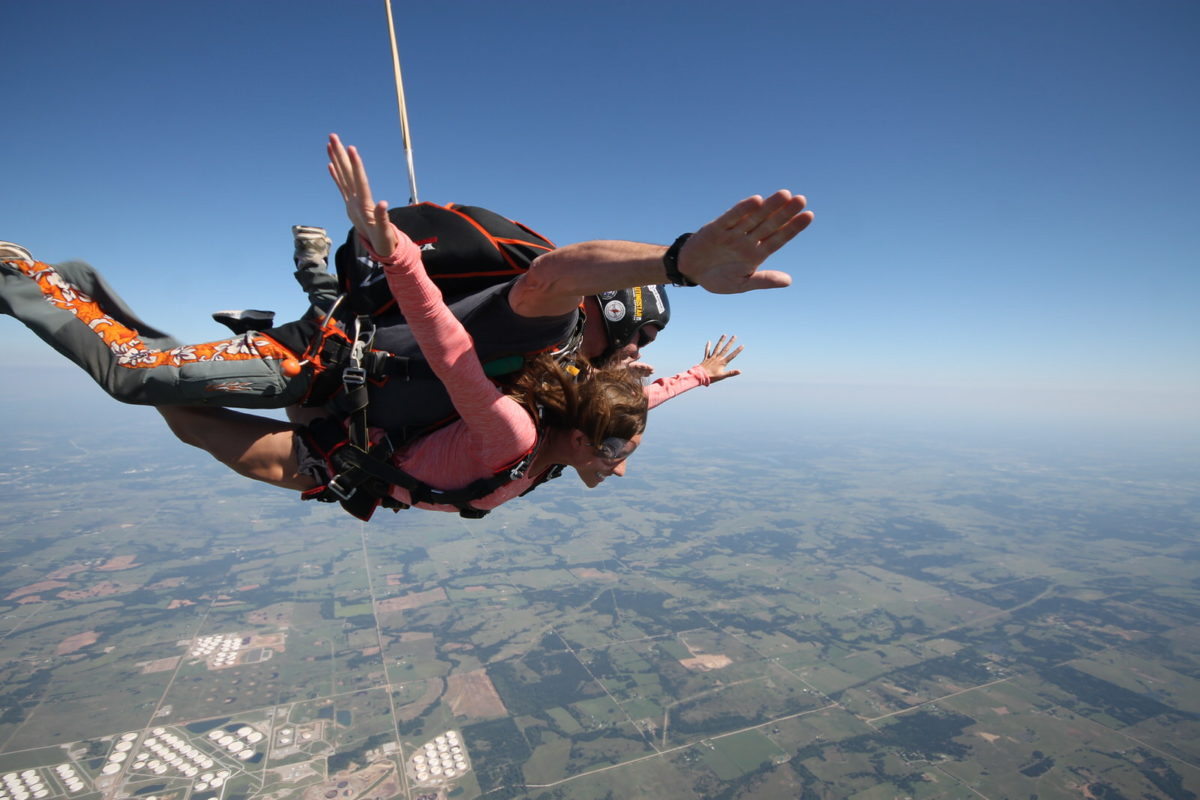How Safe is Tandem Skydiving?
Sunday, June 30, 2024
Skydiving, for many, represents the pinnacle of adrenaline-fueled adventure. Yet, as exhilarating as the idea of jumping out of an airplane might be, the question on most people’s minds is, “How safe is skydiving?” As avid skydivers, we are consistently advocating for our sport; dispelling common myths and addressing the skydiving safety based on the statistical evidence provided by the United States Parachute Association (USPA).
Is Skydiving Safe?

Without question, safety is our number one priority at Oklahoma Skydiving Center – whether this is your first jump or your one-thousandth.
Like any other extreme sport, skydiving comes with inherent risk. We do our best to mitigate those risks with proper preparation and good judgment, however, accidents can still occur. Contrary to the popular belief that skydiving accidents are due to equipment failure, most skydiving accidents are actually a result of simple human error – oftentimes an experienced skydiver who is pushing the limits and makes an error in judgment while landing a perfectly functioning parachute.
We would never say that skydiving is “safe” per se, but we can report on the diligently collected statistics from the USPA and share our confidence in our ability to handle situations as they arise with proper emergency procedures.
So, is skydiving dangerous? Yes, skydiving is a dangerous sport that should be enjoyed with extreme caution. Can skydiving be made safer with proper procedure and education? Yes!!
How Safe is Skydiving Solo?
Out of the 3.65 million skydives reported by the USPA in 2023, 10 resulted in a skydiving fatality. This makes the fatality rate index 0.27 per 100,000 jumps (1:370,000) – the lowest it has ever been since USPA record keeping began back in 1961.
In 2023, six percent of USPA members reported that they experienced an injury that required medical treatment, with the most common injury being ankle issues from poor landings.
How Safe is Tandem Skydiving?
Tandem skydiving safety statistics are more favorable than any other type of parachute jump. Over the past decade, tandem skydiving has reported one fatality per 500,000 jumps, which makes the odds of dying on a tandem skydive about 0.002% for every 1,000 jumps. So, is tandem skydiving safe? Well, no … but based on the statistics, the odds are pretty good! Is it worth the risk? We think so! And if you ask any other previous tandem jumper, we think they’ll agree.
Enhancing Skydiving Safety

We can say with full confidence that the skydiving community is dedicated to enhancing the quality and safety of skydiving. The USPA was born out of a shared goal to develop skydiving safety worldwide.
With frequent training seminars, the implementation of Safety Day every pre-season, tracking statistics, monitoring skydiving centers and holding them to the highest standards, ensuring proper training for instructors and student skydivers, and so on! Whether it is through advancing skydiving equipment or education techniques, we work every day to improve our safety standards.
Improvements in Skydiving Equipment
A primary concern about skydiving safety is equipment failure. Skydiving gear has come a long, long way – with modern technology and numerous safety features, skydiving safety culture is stronger than ever.
For starters, the skydiving rig is equipped with two parachutes: the main parachute and a back-up “reserve” parachute. The reserve parachute is meticulously maintained, undergoing regular inspection by FAA-certified parachute riggers every 180 days.
Additionally, Automatic Activation Devices (AAD) are now standard in most skydiving rigs and are required in tandem and student skydiving rigs. These devices automatically deploy the reserve parachute at a predetermined altitude if the main parachute hasn’t been deployed for whatever reason – adding an extra layer of security.
Although no equipment can be perfect, modern parachute equipment incorporates these advanced safety features and is subject to thorough testing in conditions that far exceed the stresses of a normal jump. Statistically, skydiving accidents involving equipment malfunctions are most frequently the result of the skydiver reacting incorrectly and not performing the correct emergency procedures that are taught during their skydiving training.
Enhancing Skydiving Safety Through Education

Mitigating risks is the biggest part of our job as skydivers, which is why education and preparation are critical components of skydiving safety. Those interested in skydiving are encouraged to research and choose reputable skydiving centers – like us at Oklahoma Skydiving Center – that adhere to United States Parachute Association (USPA) guidelines and standards.
A significant safety factor is the expertise of tandem instructors. Instructors must undergo extensive training and certification, logging hundreds of jumps and passing multiple exams at various levels before qualifying to take student skydivers. This extensive experience ensures that they can handle a variety of situations and make carefully practiced and informed safety decisions. Pre-jump briefings and thorough training sessions administered by USPA-certified skydiving instructors are also essential to familiarize participants with the procedures and safety measures in place. For those interested in learning to skydive, a thorough all-day ground course must be attended beforehand to ensure full understanding before attempting a skydive on their own.
While skydiving does carry inherent risk, this risk can be managed and minimized through stringent safety measures, reliable equipment, and comprehensive training. Tandem skydiving, in particular, offers a conservative introduction into the sport, allowing participants to experience the thrill of freefall with confidence in the rigorous safety protocols in place and upheld by their well-trained tandem instructor.
Congratulations, you’ve just completed the first step to skydiving safely: educating yourself on the importance of safety in skydiving! Ready to take the plunge? Don’t wait – book your tandem skydive today and discover why thousands trust Oklahoma Skydiving Center for their first jump.
Have questions? Check out our tandem skydiving FAQs or contact us directly for more information.
Copyright © 2025, Oklahoma Skydiving Center, All Rights Reserved.
DropZone Web Design & Marketing by Beyond Marketing, LLC





